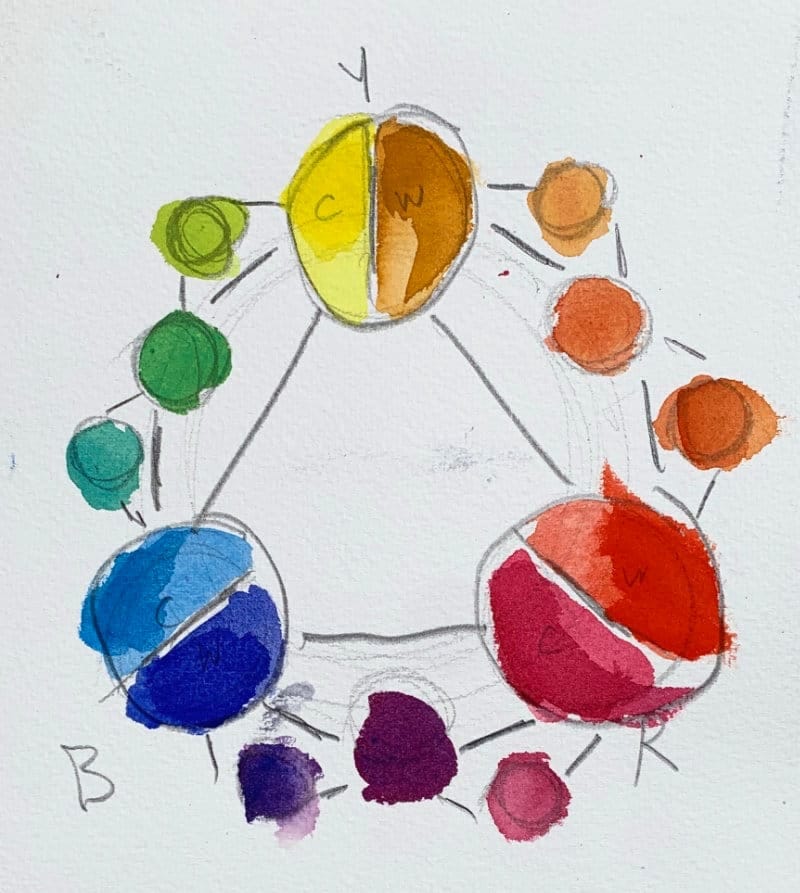Buying Watercolor Paints Is Like Buying a Car
Buying watercolor paints can feel like walking onto a car lot—so many shiny options, but only a few worth driving home. Here’s my guide to the best brands, a simple starter palette, and tips to keep your paints fresh.

Buying the best watercolor paints is a lot like shopping for a new car. You walk onto the lot and everything looks amazing—the sleek sports car, the family SUV, that little blue convertible with balloons tied to it. They all scream "take me home!"
And let's be real, you don't want to get stuck with a beater. But you also don't need to drop a fortune on every shiny thing in the showroom. The trick is finding paints that balance quality with price, so you're not crying over dried-up tubes or muddy colors six months from now.

My Go-To Watercolor Paints
I've tested a lot of paints over the years. Here are the ones I actually use and trust:
- Holbein – This is my top choice. The Mustang convertible of the bunch! Smooth texture, lovely pigment, and it's never let me down. They also have an amazing color selection if you ever want to branch out.
- Winsor & Newton – My second favorite. Very reliable, and I used them for years before switching to Holbein. If you're looking for solid quality without the luxury price tag, this is your brand.
- Daniel Smith - Honorable mention. A trusted paint used by a ton of professionals, and an excellent choice if you want top-tier quality.
I'm only recommending what I've actually used in my own studio. No fluff, just the real deal.

Keep Your Palette Minimal (This Is Where You Save Money)
Here's where I messed up early on: I thought having every color would make me a better artist. Spoiler alert—it just confused me.
Then I learned about the six primary palette, and everything changed.
With six colors—a warm and cool version of each primary—you can mix just about any color you need:
- Warm hues: Yellow ochre, Ultramarine blue, Cadmium red light
- Cool hues: Lemon yellow, Cobalt blue, Alizarin crimson
Throw in a couple of neutrals like Burnt Sienna and Neutral Tint, plus maybe a small tube of white gouache for highlights, and you're set.
That's it. Simple, minimal, and way less overwhelming. Once I figured this out, my whole approach changed. Look in my paint box right now and these are basically the only colors you'll find—maybe one or two extras I'm experimenting with, but that's rare.
👉 If you’re just starting out, check out my top picks for Best Watercolor Paper or a useful guide to The Best Watercolor Brushes.
Where I Buy My Paints
I only use Blick Art Materials. I know a lot of people shop on Amazon, but Blick knows their stuff. That's all they do—art supplies. And if something ever goes wrong (which has happened maybe once), they're quick to fix it.
Storage Tips
Life happens. Sometimes you don't get back to painting as fast as you think you will. Here's how to keep your paints fresh:
- Make sure the caps are snug (no need to go crazy, just tight)
- Store tubes in a Ziploc bag for extra protection
- Keep them in a cool, dry spot (not on a sunny windowsill)
Do this and your paints will last you years.
FAQ About Watercolor Paints
What's the difference between student and professional paints?
Student paints are like economy cars with crank windows—they work fine, but they're full of fillers and less pigment. Professional paints have richer, more vibrant colors that actually respond the way you need them to.
How many colors do I actually need?
Six primaries and a couple neutrals will get the job done. Don't overspend in the beginning. Honestly, these are probably the only colors you'll ever need.
Should I get tubes or pans?
Tubes. They're ready to go with strong, juicy color. Pans are fine for travel, but having to soften them up every time is just one extra step I don't want to deal with.
Do watercolors expire?
I've never had any go bad. As long as they stay soft and don't dry up in the tube, you're good.
Where's the best place to buy?
Blick Art. I live in the U.S., so they're accessible and always stocked.
Final Thoughts
When it comes to buying watercolor paints, keep it simple. Get good quality without breaking the bank. You don't need the shiniest, most expensive paint on the lot—just something smooth, reliable, and ready to take you wherever you wanna go on your watercolor journey.




